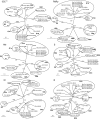Complete genome sequence of bat coronavirus HKU2 from Chinese horseshoe bats revealed a much smaller spike gene with a different evolutionary lineage from the rest of the genome
- PMID: 17617433
- PMCID: PMC7103351
- DOI: 10.1016/j.virol.2007.06.009
Complete genome sequence of bat coronavirus HKU2 from Chinese horseshoe bats revealed a much smaller spike gene with a different evolutionary lineage from the rest of the genome
Abstract
Apart from bat-SARS-CoV, we have identified a novel group 1 coronavirus, bat-CoV HKU2, in Rhinolophus sinicus (Chinese horseshoe bats). Since it has been suggested that the receptor-binding motif (RBM) of SARS-CoV may have been acquired from a group 1 coronavirus, we conducted a surveillance study and identified bat-SARS-CoV and bat-CoV HKU2 in 8.7% and 7.5% respectively of R. sinicus in Hong Kong and Guangdong. Complete genome sequencing of four strains of bat-CoV HKU2 revealed the smallest coronavirus genome (27164 nucleotides) and a unique spike protein evolutionarily distinct from the rest of the genome. This spike protein, sharing similar deletions with other group 2 coronaviruses in its C-terminus, also contained a 15-amino acid peptide homologous to a corresponding peptide within the RBM of spike protein of SARS-CoV, which was absent in other coronaviruses except bat-SARS-CoV. These suggest a common evolutionary origin in the spike protein of bat-CoV HKU2, bat-SARS-CoV, and SARS-CoV.
Figures




Similar articles
-
Genetic characterization of Betacoronavirus lineage C viruses in bats reveals marked sequence divergence in the spike protein of pipistrellus bat coronavirus HKU5 in Japanese pipistrelle: implications for the origin of the novel Middle East respiratory syndrome coronavirus.J Virol. 2013 Aug;87(15):8638-50. doi: 10.1128/JVI.01055-13. Epub 2013 May 29. J Virol. 2013. PMID: 23720729 Free PMC article.
-
Molecular diversity of coronaviruses in bats.Virology. 2006 Jul 20;351(1):180-7. doi: 10.1016/j.virol.2006.02.041. Epub 2006 May 2. Virology. 2006. PMID: 16647731 Free PMC article.
-
Epidemiology and Genomic Characterization of Two Novel SARS-Related Coronaviruses in Horseshoe Bats from Guangdong, China.mBio. 2022 Jun 28;13(3):e0046322. doi: 10.1128/mbio.00463-22. Epub 2022 Apr 25. mBio. 2022. PMID: 35467426 Free PMC article.
-
Bat origin of human coronaviruses.Virol J. 2015 Dec 22;12:221. doi: 10.1186/s12985-015-0422-1. Virol J. 2015. PMID: 26689940 Free PMC article. Review.
-
Properties of Coronavirus and SARS-CoV-2.Malays J Pathol. 2020 Apr;42(1):3-11. Malays J Pathol. 2020. PMID: 32342926 Review.
Cited by
-
Bat Rhinacoviruses Related to Swine Acute Diarrhoea Syndrome Coronavirus Evolve under Strong Host and Geographic Constraints in China and Vietnam.Viruses. 2024 Jul 11;16(7):1114. doi: 10.3390/v16071114. Viruses. 2024. PMID: 39066276 Free PMC article.
-
Individual virome analysis reveals the general co-infection of mammal-associated viruses with SARS-related coronaviruses in bats.Virol Sin. 2024 Aug;39(4):565-573. doi: 10.1016/j.virs.2024.06.008. Epub 2024 Jun 28. Virol Sin. 2024. PMID: 38945213 Free PMC article.
-
Information Theoretic Study of COVID-19 Genome.Entropy (Basel). 2024 Mar 1;26(3):223. doi: 10.3390/e26030223. Entropy (Basel). 2024. PMID: 38539735 Free PMC article.
-
Functional dissection of the spike glycoprotein S1 subunit and identification of cellular cofactors for regulation of swine acute diarrhea syndrome coronavirus entry.J Virol. 2024 Apr 16;98(4):e0013924. doi: 10.1128/jvi.00139-24. Epub 2024 Mar 19. J Virol. 2024. PMID: 38501663 Free PMC article.
-
Research Advances on Swine Acute Diarrhea Syndrome Coronavirus.Animals (Basel). 2024 Jan 30;14(3):448. doi: 10.3390/ani14030448. Animals (Basel). 2024. PMID: 38338091 Free PMC article. Review.
References
-
- Apweiler R., Attwood T.K., Bairoch A., Bateman A., Birney E., Biswas M., Bucher P., Cerutti L., Corpet F., Croning M.D., Durbin R., Falquet L., Fleischmann W., Gouzy J., Hermjakob H., Hulo N., Jonassen I., Kahn D., Kanapin A., Karavidopoulou Y., Lopez R., Marx B., Mulder N.J., Oinn T.M., Pagni M., Servant F., Sigrist C.J., Zdobnov E.M. The InterPro database, an integrated documentation resource for protein families, domains and functional sites. Nucleic Acids Res. 2001;29:37–40. - PMC - PubMed
Publication types
MeSH terms
Substances
Associated data
- Actions
- Actions
- Actions
- Actions
LinkOut - more resources
Full Text Sources
Miscellaneous

